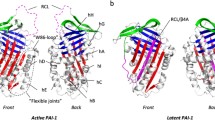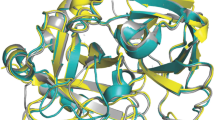Abstract
In silico alanine scanning mutagenesis on the cleavable isoform of mucin 1 revealed isoleucine 67 as one of the key factors contributing to the strain at the autoproteolytic cleavage site. In this study, we demonstrate the structural basis of isoleucine-induced rigidity towards the strain-driven autoproteolysis at G−1S+1 cleavage site of mucin 1. We further evaluated the gain in flexibility upon isoleucine 67 mutation through molecular dynamics and essential dynamics studies. The results show that the mutant exhibits stability in its secondary structural elements while the native displays a less-bonded network, however the cleavage site of native remains constrained. Essential dynamics revealed that large motions of the mutant were confined to the loop although the internal domain of the structure remains unaffected. Also, the mutation exerted a larger effect on the intraprotein interactions and consequently resulted in a stabilized motif at the cleavage. Analyses on MD trajectory conformations illustrate a completely disrupted motif in native as an effect of the peptide strain. The study also revealed that in mutant, the cleavage competent catalytic groups C=O and OG were in geometrical aspects unfavorable for a nucleophilic attack. The results support the earlier speculation that the presence of bulky isoleucine proximal G−1S+1 cleavage site limits the conformational sampling of residues and therefore maintains the residues in a torsionally restrained conformation.







Similar content being viewed by others
References
Akhavan A, Crivelli SN, Singh M, Lingappa VR, Muschler JL (2008) SEA domain proteolysis determines the functional composition of dystroglycan. FASEB J 22:612–621
Armen R, Alonso DO, Daggett V (2003) The role of alpha-, 3(10)-, and pi-helix in helix–> coil transitions. Protein Sci 12:1145–1157
Barsky D, Foloppe D, Ahmadia S, Wilson DM, MacKerell AD Jr (2000) New insights into the structure of abasic DNA from molecular dynamics simulations. Nucleic Acids Res 28:2613–2626
Chikalov I, Yao P, Moshkov M, Latombe JC (2011) Learning probabilistic models of hydrogen bond stability from molecular dynamics simulation trajectories. BMC Bioinform 12:S34
Craveur P, Joseph AP, Poulain P, de Brevern AG, Rebehmed J (2013) Cis-trans isomerization of omega dihedrals in proteins. Amino Acids 45:279–289
David CC (2012) Essential dynamics of proteins using geometrical simulations and subspace analysis. Dissertation, The University of North Carolina at Charlotte
DeLano WL (2009) The PyMOL molecular graphics system. http://www.pymol.org. Accessed 19 May 2014
Dobbins SE, Lesk VI, Sternberg MJ (2008) Insights into protein flexibility: the relationship between normal modes and conformational change upon protein–protein docking. Proc Natl Acad Sci USA 105:10390–10395
Falconi M, Biocca S, Novelli G, Desideri A (2007) Molecular dynamics simulation of human LOX-1 provides an explanation for the lack of OxLDL binding to the Trp150Ala mutant. BMC Struct Biol 7:73
Fischer G, Kosinska-Eriksson U, Aponte-Santamaria C, Palmgren M, Geijer C, Hedfalk K, Hohmann S, de Groot BL, Neutze R, Lindkvist-Petersson K (2009) Crystal structure of a yeast aquaporin at 1.15 angstrom reveals a novel gating mechanism. PLoS Biol 7:e1000130
Friedman R, Caflisch A (2008) Pepsinogen-like activation intermediate of plasmepsin II revealed by molecular dynamics analysis. Proteins 73:814–827
Hey NA, Meseguer M, Simon C, Smorodinsky NI, Wreschner DH, Ortiz ME, Aplin JD (2003) Transmembrane and truncated (SEC) isoforms of MUC1 in the human endometrium and Fallopian tube. Reprod Biol Endocrinol 13:1–2
Huang W, Aboul-ela F, Jha S, Boyapati V (2008) In Computational study of conformational switching of s-box riboswitch. In: Proceedings of the 235th ACS National Meeting, New Orleans
Humphrey W, Dalke A, Schulten K (1996) VMD: visual molecular dynamics. J Mol Graph 14:33–38
Johansson DGA, Macao B, Sandberg A, Hard T (2008) SEA domain autoproteolysis accelerated by conformational strain: mechanical aspects. J Mol Biol 377:1130–1143
Kahn K, Bruice TC (2002) Parameterization of OPLS–AA force field for the conformational analysis of macrocyclic polyketides. J Comput Chem 23:977–996
Karplus M, Kuriyan J (2005) Molecular dynamics and protein function. Proc Natl Acad Sci U S A 102:6679–6685
Karplus M, McCammon JA (2002) Molecular dynamics simulations of biomolecules. Nat Struct Biol 9:646–652
Kumari JL, Sudandiradoss C (2013) Computational investigation of theoretical models of cleavable and uncleavable mucin 1 isoforms. Mol BioSyst 9:2473–2488
Leroy X, Buisine MP, Leteurtre E, Aubert S, Buob D, Porchet N, Copin MC (2006) MUC1 (EMA): a key molecule of carcinogenesis? Ann Pathol 26:257–266
Levitin F, Stern O, Weiss M, Gil-Henn C, Ziv R, Prokocimer Z, Smorodinsky NI, Rubinstein DB, Wreschner DH (2005) The MUC1 SEA module is a self-cleaving domain. J Biol Chem 280:33374–33386
Lorenzo-Seva U (2013) How to report the percentage of explained common variance in exploratory factor analysis. Technical Report. Department of Psychology, Universitat Rovira i Virgili, Tarragona
Macao B, Johansson DG, Hansson GC, Hard T (2006) Autoproteolysis coupled to protein folding in the SEA domain of the membrane-bound MUC1 mucin. Struct Mol Biol 13:71–76
Palmai-Pallag T, Khodabukus N, Kinarsky L, Leir SH, Sherman S, Hollingsworth MA, Harris A (2005) The role of the SEA (sea urchin sperm protein, enterokinase and agrin) module in cleavage of membrane-tethered mucins. FEBS J 272:2901–2911
Peters GH, Bywater RP (1999) Computational analysis of chain flexibility and fluctuations in Rhizomucor miehei lipase. Protein Eng 12:747–754
Rodziewicz-Motowidlo S, Wahlbom M, Wang X, Lagiewka J, Janowski R, Jaskolski M, Grubb A, Grzonka Z (2006) Checking the conformational stability of cystatin C and its L68Q variant by molecular dynamics studies: why is the L68Q variant amyloidogenic? J Struct Biol 154:68–78
Shenai PM, Xu Z, Zhao Y (2012) Applications of Principal Component Analysis (PCA) in Materials Science. In: Sanguansat P (ed) Principal Component Analysis- Engineering Applications. InTech Publishers, Shanghai, pp 25–40
Singh R, Bandyopadhyay D (2007) MUC1: a target molecule for cancer therapy: protein Engineering and Biotherapy. Cancer Biol Ther 6:481–486
Tao Y, Rao ZH, Liu SQ (2010) Insight derived from molecular dynamics simulation into substrate-induced changes in protein motions of proteinase K. J Biomol Struct Dyn 28:143–158
van der Spoel D, van Maaren PJ, Larsson P, Tîmneanu N (2006) Thermodynamics of hydrogen bonding in hydrophilic and hydrophobic media. Phys Chem B 110:4393–4398
Wreschner DH, McGuckin MA, Williams SJ, Baruch A, Yoeli M, Ziv R, Okun L, Zaretsky J, Smorodinsky N, Keydar I, Neophytou P, Stacey M, Lin HH, Gordon S (2002) Generation of ligand-receptor alliances by “SEA” module-mediated cleavage of membrane-associated mucin proteins. Protein Sci 11:698–706
Wu D, Smith S, Mahan H, Jernigan RL, Wu Z (2011) Analysis of protein dynamics using local-DME calculations. Int J Bioinform Res Appl 7:146–161
Xiong B, Huang XQ, Shen XQ, Shen JH, Luo XM, Shen X, Jiang HL, Chen KX (2004) Conformational flexibility of beta-secretase: molecular dynamics simulation and essential dynamics analysis. Acta Pharmacol Sin 25:705–713
Yamaguchi H (1998) Essential dynamics of DNA containing a cis.syn cyclobutane thymine dimer lesion. Nucl Acids Res 26:1939–1946
Yang E, Hu XF, Xing PX (2007) Advances of MUC1 as a target for breast cancer immunotherapy. Histol Histopathol 22:905–922
Zaretsky JZ, Barnea I, Aylon Y, Gorivodsky M, Wreschner DH, Iafa K (2006) MUC1 gene overexpressed in breast cancer: structure and transcriptional activity of the MUC1 promoter and role of estrogen receptor alpha (ERalpha) in regulation of the MUC1 gene expression. Mol Cancer 5:57
Acknowledgments
The authors thank the management of VIT University for providing the facilities and encouragement to carry out this work.
Conflict of interest
The authors declare no conflicts of interest.
Author information
Authors and Affiliations
Corresponding author
Electronic supplementary material
Below is the link to the electronic supplementary material.
Rights and permissions
About this article
Cite this article
Kumari, J.L.J., Sudandiradoss, C. Exploring the structural constraints at cleavage site of mucin 1 isoform through molecular dynamics simulation. Eur Biophys J 44, 309–323 (2015). https://doi.org/10.1007/s00249-015-1023-z
Received:
Revised:
Accepted:
Published:
Issue Date:
DOI: https://doi.org/10.1007/s00249-015-1023-z




